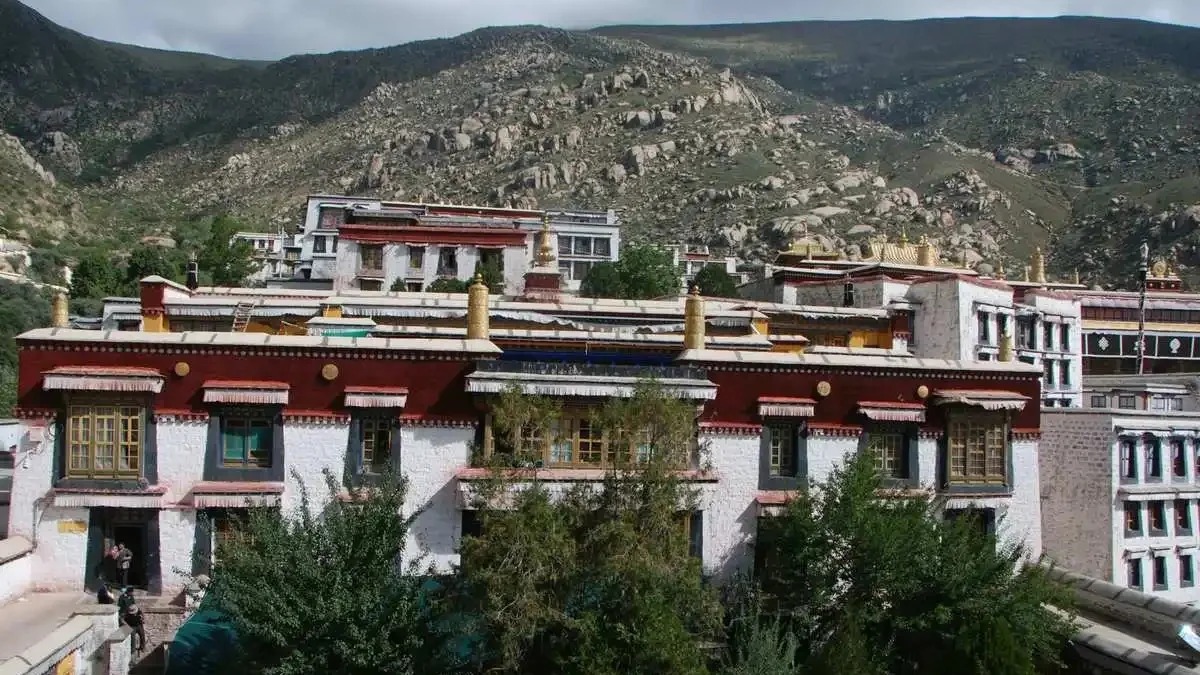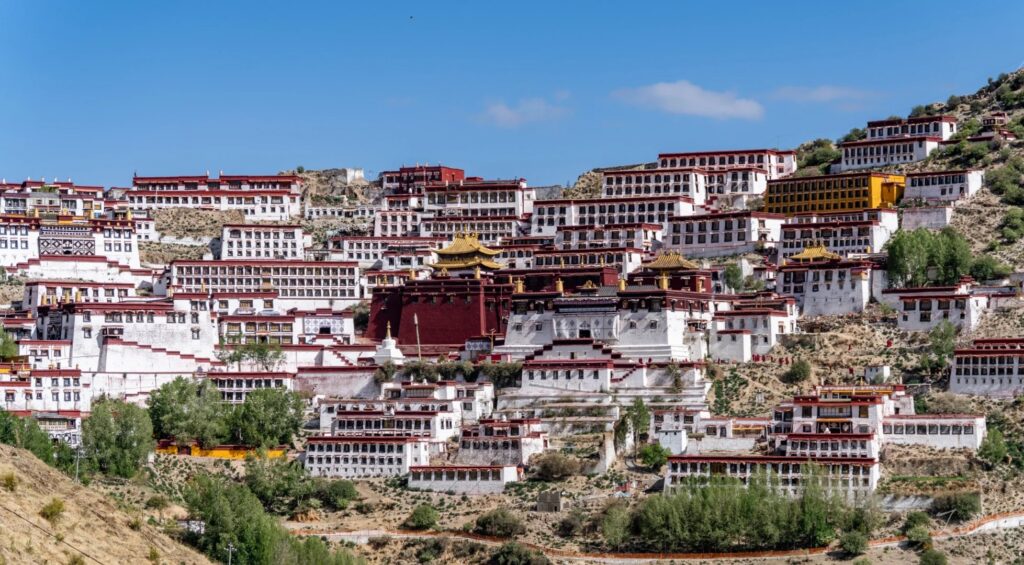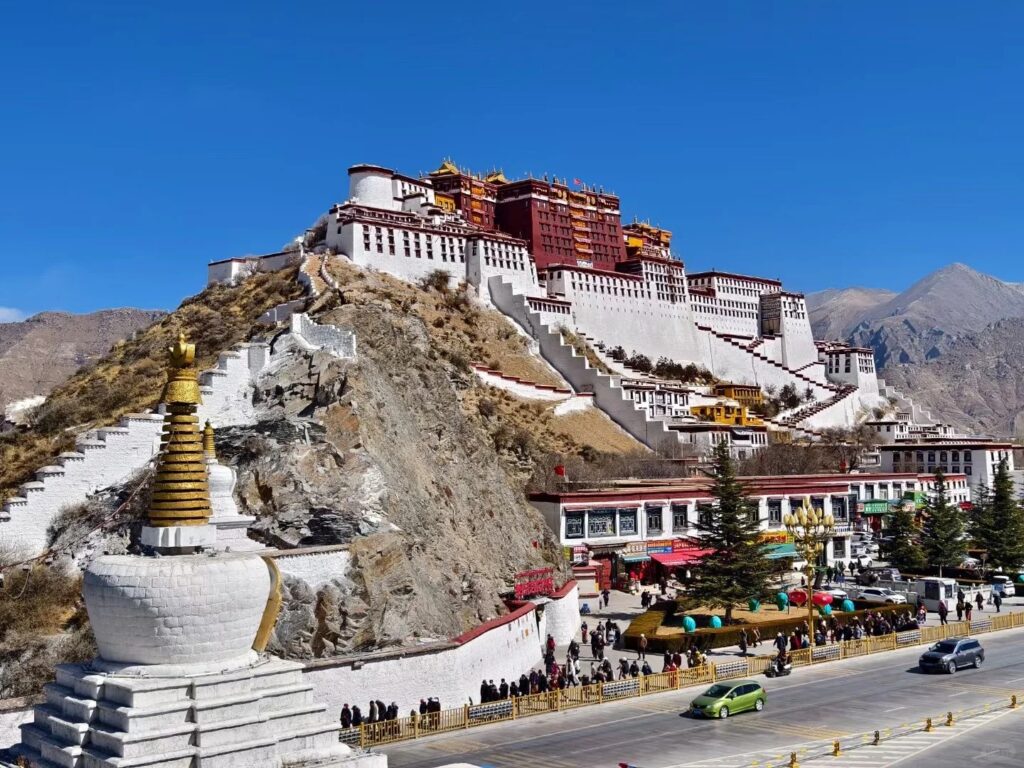Visiting Information
| Information | Details |
|---|---|
| Chinese Name | 哲蚌寺 (Zhébàng Sì) |
| Location and Address | Ganden Podrang, Drepung Monastery, Lhasa, Tibet Autonomous Region, China |
| Opening Time/Hours | 9:00 AM – 5:00 PM (May to October) 9:30 AM – 4:00 PM (November to April) |
| Entrance Fee | 55 CNY for adults Free for children under 1.2 meters tall |
| How to Get There | By Bus: Take Bus No. 24 or 25 from Lhasa city center By Taxi: About 20-30 minutes drive from Lhasa city center (No metro service in Lhasa) |
| Best Time for Visit | May to October, especially during the Shoton Festival (usually in August) |
| Contact Info | Phone: +86 891 6852531 |
Overview
Drepung Monastery, located on the outskirts of Lhasa, Tibet, is one of the “great three” Gelug university monasteries of Tibet. Founded in 1416, it was once the largest monastery in the world, housing up to 10,000 monks. Today, it remains a significant center of Tibetan Buddhism, attracting both pilgrims and tourists with its rich history, impressive architecture, and cultural importance.
Historical Background
Drepung Monastery was founded in 1416 by Jamyang Choge Tashi Palden, a disciple of Je Tsongkhapa, the founder of the Gelug school of Tibetan Buddhism. The name “Drepung” means “Rice Heap” in Tibetan, which refers to the appearance of the monastery from afar. Throughout its history, Drepung has played a crucial role in Tibetan politics and religion. It served as the residence of the Dalai Lamas before the Potala Palace was built in the 17th century. The monastery has faced challenges, including damage during the Cultural Revolution, but has since been partially restored and continues to function as an important religious institution.
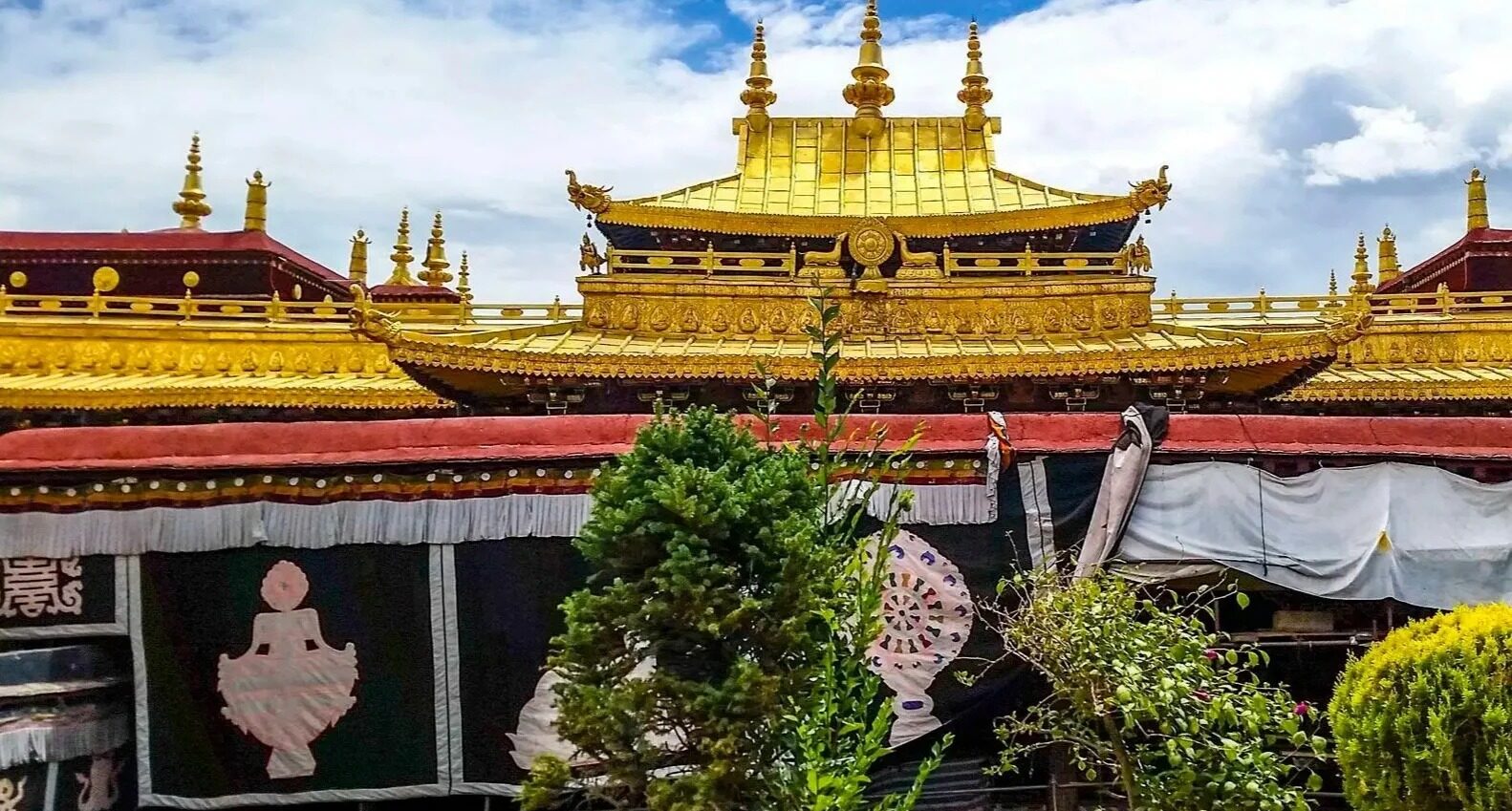
Architectural Features
- Ganden Podrang: This building, located within Drepung Monastery, was the original residence of the Dalai Lamas before the construction of the Potala Palace. It is a magnificent structure that showcases traditional Tibetan architectural styles, featuring intricate carvings, colorful paintings, and gilded roofs. The Ganden Podrang serves as a testament to the monastery’s historical importance and its connection to Tibet’s political and spiritual leadership.
- Four Colleges: Drepung Monastery is composed of four colleges: Loseling, Gomang, Deyang, and Ngagpa. Each college has its own assembly hall, dormitories, and kitchen. The assembly halls are particularly impressive, with their massive pillars, intricate murals, and rows of low tables where monks study and debate. These colleges represent different lineages and specializations within the Gelug tradition, contributing to the monastery’s role as a comprehensive center of Buddhist learning.
- Coqen Hall: This is the main assembly hall of Drepung Monastery, capable of holding several thousand monks. The hall is adorned with elaborate thangkas (Tibetan Buddhist paintings), statues of Buddhist deities, and other religious artifacts. The ceiling is supported by 183 pillars, and the walls are covered with murals depicting various Buddhist scenes and teachings. Coqen Hall serves as the heart of the monastery, where important ceremonies and gatherings take place.
- White Pagoda: Located at the highest point of the monastery, the White Pagoda is a distinctive landmark visible from afar. It is a stupa-like structure that contains relics and serves as a focal point for circumambulation by pilgrims. The pagoda offers panoramic views of the monastery complex and the surrounding Lhasa valley, making it a popular spot for both worship and sightseeing.
Cultural Importance
Drepung Monastery holds immense cultural significance in Tibetan Buddhism and Tibetan history. As one of the largest and most influential monasteries in Tibet, it has been a center of learning, spiritual practice, and cultural preservation for centuries. The monastery has produced many renowned scholars and spiritual leaders, including several Dalai Lamas. It plays a crucial role in maintaining Tibetan Buddhist traditions, including philosophical debates, religious ceremonies, and the transmission of sacred texts. The annual Shoton Festival, which begins at Drepung, is a major cultural event that attracts thousands of pilgrims and visitors. The monastery’s vast collection of scriptures, artworks, and artifacts represents a treasure trove of Tibetan cultural heritage.
Surrounding Attractions
- Nechung Monastery: Located near Drepung, Nechung Monastery was the seat of the State Oracle of Tibet. This smaller but historically significant monastery is known for its colorful murals and its connection to Tibetan spiritual and political traditions. Visitors can explore the atmospheric prayer halls and learn about the role of oracles in Tibetan Buddhism and governance.
- Sera Monastery: Another of the “great three” Gelug monasteries, Sera is famous for its monk debates. Located north of Lhasa, it offers visitors a chance to witness the unique spectacle of monks engaged in philosophical debates, complete with dramatic gestures. The monastery also features impressive assembly halls and a rich collection of Buddhist artifacts.
- Potala Palace: This iconic symbol of Tibet was the winter palace of the Dalai Lamas from the 7th century. The massive structure, with its distinctive white and red facades, dominates the Lhasa skyline. Visitors can explore its numerous rooms, chapels, and galleries, which house a vast collection of Tibetan art and historical relics.
- Jokhang Temple: Considered the spiritual heart of Tibet, Jokhang Temple is located in the center of old Lhasa. It houses a famous statue of the Buddha that is said to have been brought to Tibet by Princess Wencheng in the 7th century. The temple is surrounded by the bustling Barkhor Street, where pilgrims perform circumambulations and visitors can shop for traditional Tibetan goods.

Photography Opportunities
- Monastery Exterior: The sprawling white buildings of Drepung Monastery set against the backdrop of the Tibetan mountains offer stunning photographic opportunities. The best vantage point is from the hill opposite the monastery, especially during the early morning or late afternoon when the light casts long shadows and enhances the textures of the buildings. The contrast between the white structures and the surrounding natural landscape creates visually striking images.
- Interior Halls and Artwork: Inside the monastery, photographers can capture the rich details of Tibetan Buddhist art and architecture. The assembly halls, with their colorful murals, intricate statues, and rows of ancient texts, provide fascinating subjects. Pay attention to the play of light filtering through windows onto golden Buddha statues or illuminating the faces of praying monks. Remember to respect photography restrictions in certain sacred areas.
- Monk Debates and Rituals: The lively philosophical debates and religious ceremonies offer dynamic photographic subjects. Capture the animated expressions and gestures of debating monks in the courtyards, or the serene atmosphere of prayer sessions. These scenes provide insight into the daily life and traditions of the monastery. During festivals, such as the Shoton Festival, there are additional opportunities to photograph colorful rituals and celebrations.
- Panoramic Views: From the upper levels of the monastery and especially from the White Pagoda, photographers can capture sweeping views of the entire monastery complex and the Lhasa valley beyond. These vantage points are particularly beautiful during the golden hours of sunrise and sunset, when the light bathes the landscape in warm hues. On clear days, the distant snow-capped Himalayan peaks add an extra dimension to the panoramic shots.
Modern Importance
- Religious Education: Drepung Monastery continues to play a vital role in Tibetan Buddhist education. Despite historical challenges, it remains an active center of learning where monks study Buddhist philosophy, debate scriptural interpretations, and practice meditation. The monastery’s commitment to preserving and transmitting traditional knowledge ensures the continuity of Tibetan Buddhist scholarship in the modern era.
- Cultural Preservation: In an era of rapid modernization, Drepung Monastery serves as a bastion of Tibetan cultural heritage. Its vast libraries, art collections, and ongoing religious practices help preserve Tibetan language, art forms, and spiritual traditions. The monastery’s efforts in maintaining and restoring its architectural and artistic treasures contribute significantly to the preservation of Tibet’s unique cultural identity.
- Tourism and Economic Impact: As one of Tibet’s most famous monasteries, Drepung attracts numerous domestic and international tourists. This influx of visitors contributes to the local economy, providing income opportunities for guides, artisans, and local businesses. The monastery’s role in tourism helps raise awareness about Tibetan culture and history on a global scale, while also presenting challenges in balancing religious sanctity with tourism development.
- Interfaith and International Relations: Drepung Monastery, with its historical significance and continued importance, plays a role in interfaith dialogue and international cultural exchange. It hosts visits from religious leaders, scholars, and diplomats from around the world, fostering understanding and dialogue between different cultures and belief systems. These interactions contribute to global discussions on religious tolerance, cultural preservation, and the role of spiritual traditions in the modern world.
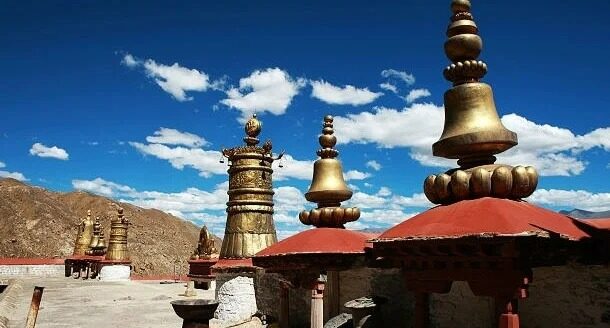
FAQ
- What is Drepung Monastery famous for?
Drepung Monastery is famous for being one of the largest monasteries in Tibet, its historical role as the residence of Dalai Lamas, its impressive architecture, and its significance in Tibetan Buddhist education and culture. - What’s inside Drepung Monastery?
Inside Drepung Monastery, visitors can find large assembly halls, numerous shrines and chapels, ancient scriptures, Buddhist artifacts, intricate murals and thangkas, and living quarters for monks. The Ganden Podrang, former residence of Dalai Lamas, is also located within the monastery complex. - Is Drepung Monastery free?
No, Drepung Monastery is not free. There is an entrance fee of 55 CNY for adults. Children under 1.2 meters tall can enter for free. - Is Drepung Monastery worth visiting?
Yes, Drepung Monastery is definitely worth visiting. It offers a unique insight into Tibetan Buddhist culture, impressive architecture, beautiful artwork, and stunning views of Lhasa valley. It’s an essential stop for anyone interested in Tibetan history and Buddhism. - What to do in Drepung Monastery?
At Drepung Monastery, you can:
1. Explore the various assembly halls and chapels
2. Observe or participate in prayer sessions
3. Watch monk debates (if timing allows)
4. Visit the Ganden Podrang
5. Climb to the White Pagoda for panoramic views
6. Learn about Tibetan Buddhist art and iconography
7. Join a guided tour to understand the monastery’s history and significance
8. Participate in the Shoton Festival if visiting in August - How do I get to Drepung Monastery in the local city?
In Lhasa, you can reach Drepung Monastery by:
1. Bus: Take Bus No. 24 or 25 from Lhasa city center
2. Taxi: It’s about a 20-30 minute drive from Lhasa city center
3. Organized tour: Many local travel agencies offer tours that include transportation
Note that Lhasa does not have a metro system. - How to visit Drepung Monastery?
To visit Drepung Monastery:
1. Check the opening hours (9:00 AM – 5:00 PM from May to October, 9:30 AM – 4:00 PM from November to April)
2. Purchase tickets at the entrance
3. Consider hiring a local guide for better understanding of the site
4. Dress modestly and respectfully
5. Be mindful of altitude as Lhasa is at high elevation
6. Respect religious customs and photography restrictions
7. Allow at least 2-3 hours for your visit
8. Visit in the morning to see more monastic activities
9. Remember to bring your passport, as it may be required for entry


